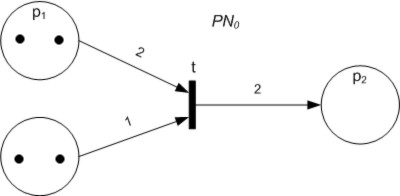|
Theory Of Regions
The Theory of regions is an approach for synthesizing a Petri net from a transition system. As such, it aims at recovering concurrent, independent behavior from transitions between global states. Theory of regions handles elementary net systems as well as P/T nets and other kinds of nets. An important point is that the approach is aimed at the synthesis of unlabeled Petri nets only. Definition A region of a transition system (S, \Lambda, \rightarrow) is a mapping assigning to each state s \in S a number \sigma(s) (natural number for P/T nets, binary Binary may refer to: Science and technology Mathematics * Binary number, a representation of numbers using only two digits (0 and 1) * Binary function, a function that takes two arguments * Binary operation, a mathematical operation that ta ... for ENS) and to each transition label a number \tau(\ell) such that consistency conditions \sigma(s') = \sigma(s) + \tau(\ell) holds whenever (s,\ell,s') \in \rightarrow. Int ... [...More Info...] [...Related Items...] OR: [Wikipedia] [Google] [Baidu] |
Petri Net
A Petri net, also known as a place/transition (PT) net, is one of several mathematical modeling languages for the description of distributed systems. It is a class of discrete event dynamic system. A Petri net is a directed bipartite graph that has two types of elements, places and transitions. Place elements are depicted as white circles and transition elements are depicted as rectangles. A place can contain any number of tokens, depicted as black circles. A transition is enabled if all places connected to it as inputs contain at least one token. Some sources state that Petri nets were invented in August 1939 by Carl Adam Petri—at the age of 13—for the purpose of describing chemical processes. Like industry standards such as UML activity diagrams, Business Process Model and Notation, and event-driven process chains, Petri nets offer a graphical notation for stepwise processes that include choice, iteration, and concurrent execution. Unlike these standards, Petri nets hav ... [...More Info...] [...Related Items...] OR: [Wikipedia] [Google] [Baidu] |
Transition System
In theoretical computer science, a transition system is a concept used in the study of computation. It is used to describe the potential behavior of discrete systems. It consists of states and transitions between states, which may be labeled with labels chosen from a set; the same label may appear on more than one transition. If the label set is a singleton, the system is essentially unlabeled, and a simpler definition that omits the labels is possible. Transition systems coincide mathematically with abstract rewriting systems (as explained further in this article) and directed graphs. They differ from finite-state automata in several ways: * The set of states is not necessarily finite, or even countable. * The set of transitions is not necessarily finite, or even countable. * No "start" state or "final" states are given. Transition systems can be represented as directed graphs. Formal definition Formally, a transition system is a pair (S, \rightarrow) where S is a set of ... [...More Info...] [...Related Items...] OR: [Wikipedia] [Google] [Baidu] |
Natural Number
In mathematics, the natural numbers are those numbers used for counting (as in "there are ''six'' coins on the table") and ordering (as in "this is the ''third'' largest city in the country"). Numbers used for counting are called ''Cardinal number, cardinal numbers'', and numbers used for ordering are called ''Ordinal number, ordinal numbers''. Natural numbers are sometimes used as labels, known as ''nominal numbers'', having none of the properties of numbers in a mathematical sense (e.g. sports Number (sports), jersey numbers). Some definitions, including the standard ISO/IEC 80000, ISO 80000-2, begin the natural numbers with , corresponding to the non-negative integers , whereas others start with , corresponding to the positive integers Texts that exclude zero from the natural numbers sometimes refer to the natural numbers together with zero as the whole numbers, while in other writings, that term is used instead for the integers (including negative integers). The natural ... [...More Info...] [...Related Items...] OR: [Wikipedia] [Google] [Baidu] |
Binary Number
A binary number is a number expressed in the base-2 numeral system or binary numeral system, a method of mathematical expression which uses only two symbols: typically "0" (zero) and "1" ( one). The base-2 numeral system is a positional notation with a radix of 2. Each digit is referred to as a bit, or binary digit. Because of its straightforward implementation in digital electronic circuitry using logic gates, the binary system is used by almost all modern computers and computer-based devices, as a preferred system of use, over various other human techniques of communication, because of the simplicity of the language and the noise immunity in physical implementation. History The modern binary number system was studied in Europe in the 16th and 17th centuries by Thomas Harriot, Juan Caramuel y Lobkowitz, and Gottfried Leibniz. However, systems related to binary numbers have appeared earlier in multiple cultures including ancient Egypt, China, and India. Leibniz was specifica ... [...More Info...] [...Related Items...] OR: [Wikipedia] [Google] [Baidu] |
